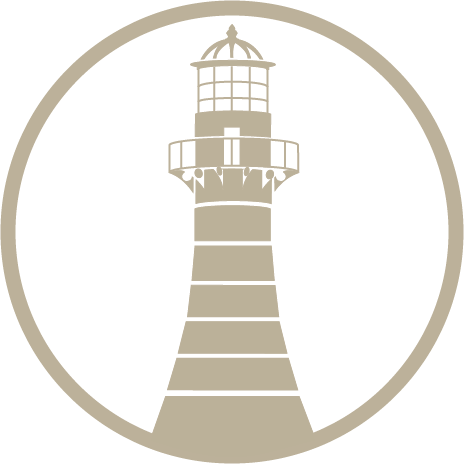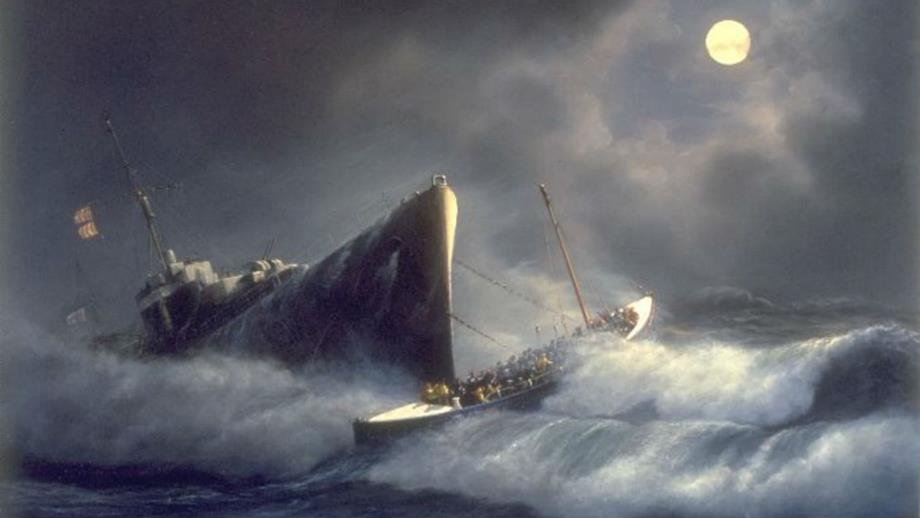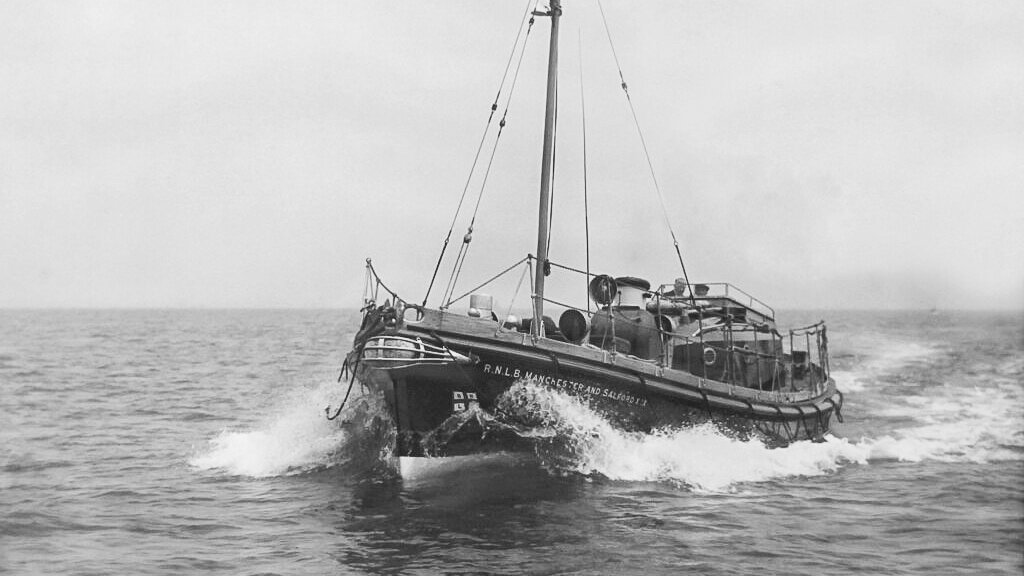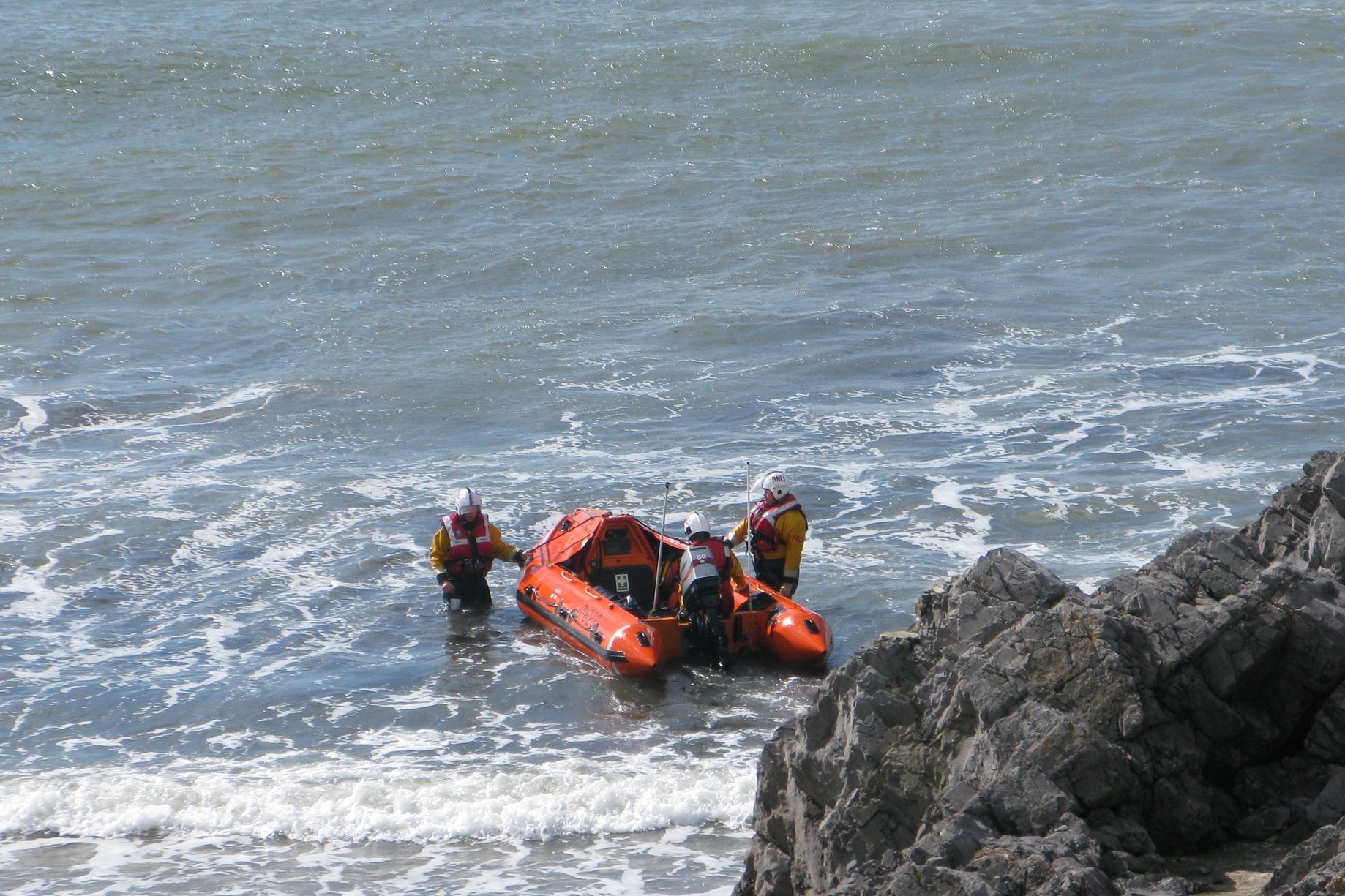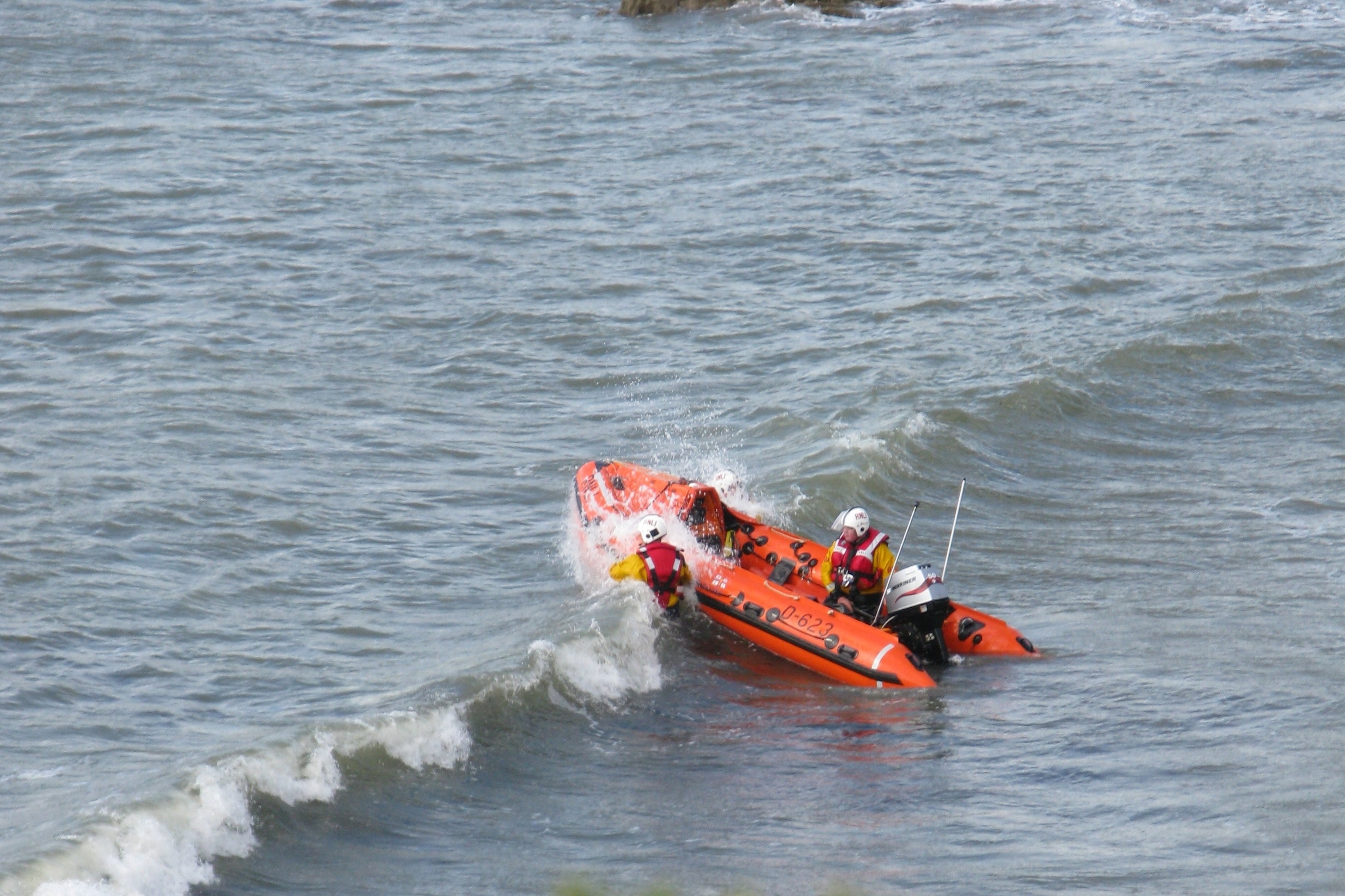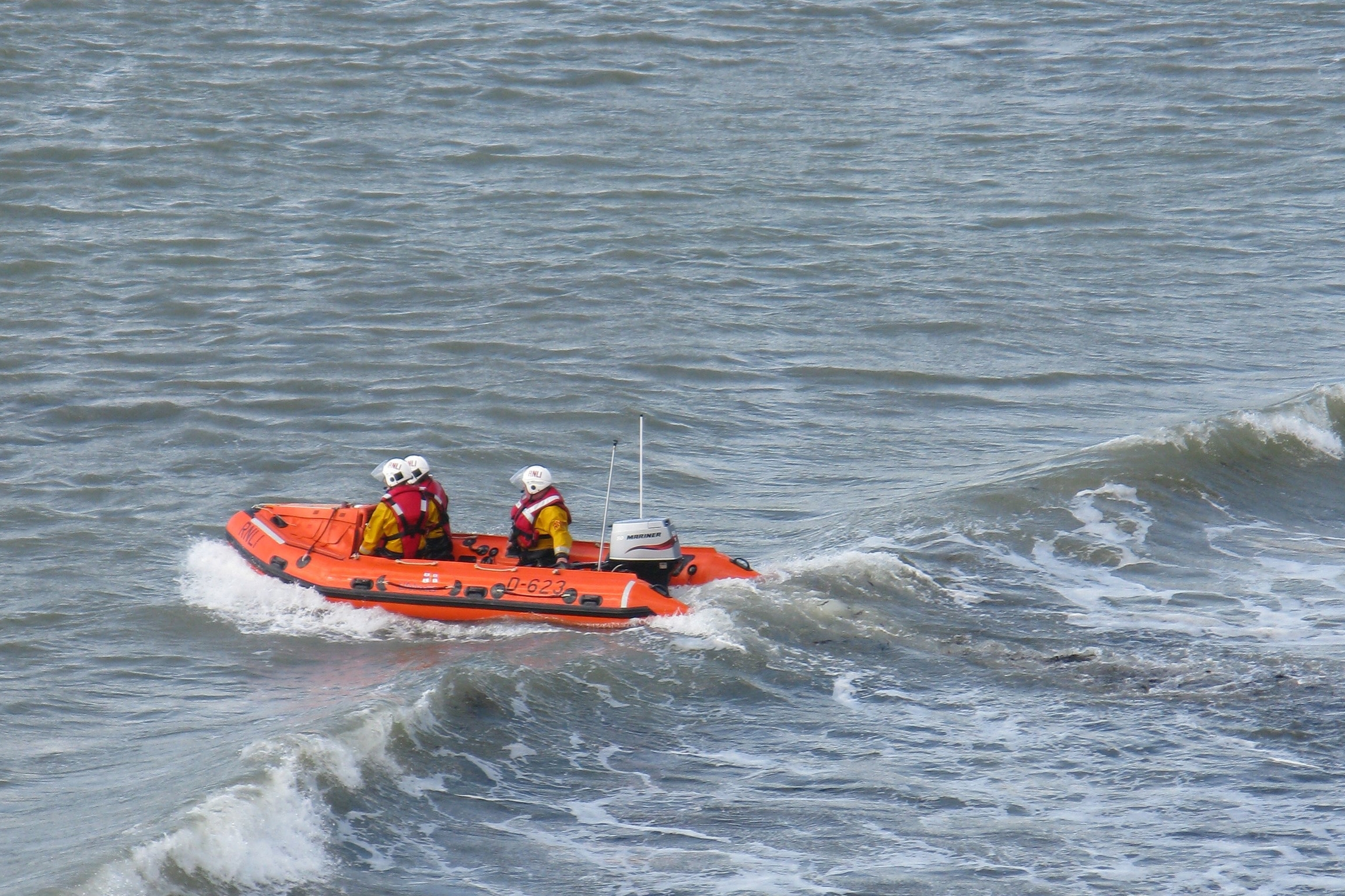The Mumbles Lifeboat
The local MP, J H Vivian, arranged for the purchase of a lifeboat from the Institution in September 1835. Swansea Harbour Trustees were in charge until 1863 when the Institution assumed authority. Mumbles has always had a lifeboat station, however, it was called Swansea. ln 1904 Swansea became an independent financial branch was referred to as Swansea, Mumbles, and Port Eynon. Swansea and Mumbles became one branch again in 1940.
Visiting times
Station visiting times are normally 11 am - 5 pm.
Visiting is subject to volunteer availability so it's worth calling the station to check it will be open when you plan to visit.
From 1835 to 1866 a lifeboat was kept at Swansea, at first in the river and then in the South Dock after 1859. A new station was provided in Mumbles for the lifeboat which was a far better place as the crew were familiar with local waters. At first, the RNLI provided an open boat pulled by 10 oars called the “Martin and Ann”. The Duke of Beaufort gave land to build a boathouse halfway between the last houses in Southend and the Mumbles Head. The boathouse still has an RNLI badge on the front of it.
A slipway couldn't be built in 1865 because of Dickson’s extension of the Mumbles Railway. When the boat arrived in 1866 it had to be kept in a carriage in the open. Enough Mumbles men volunteered to make up a full and reserve crew. The boats were given to Mumbles by other towns, fundraising committees like Wolverhampton. The first engine boat arrived in 1924. The RNLI regarded engine powered boats as being safer and more suitable for rescuing larger boats. Following the First World War, a lifeboat house was built on pilings alongside the pier, allowing a lifeboat to be launched at any time, regardless of the tide.
The Mumbles Lifeboat: ON1307 Roy Barker IV
The Mumbles Lifeboat station is currently home to a Tamar class lifeboat, ON1307 Roy Barker IV and this vessel was placed on service on 8 February 2014. The previous Lifeboat House still remains alongside the pier and was built in 1922. In May 1965, an inshore lifeboat station was established close by and this operates a smaller inflatable boat.
History
Medal Record
Nineteen medals have been awarded, one Gold, 13 Silver and five Bronze, the last, a silver, being voted in 1971. The station has also witnessed tragedy with 18 lifeboat volunteers losing their lives while endeavouring to save others.
1883
On 14 October 1833, John Bevan, Master of the schooner Gower, was given a Silver Medal for swimming with the lead line around his body to the ship Ann and Margaret, which had run aground at Aberavon.
1835
William Evans received a Silver Medal for saving two of the three crew members from the sloop John, which ran aground at Neath on October 26, 1835. After one of the crew members drowned while attempting to swim ashore, the Master and the other crew member climbed to the rigging to avoid the full force of the waves. Several larger, decked vessels' captains declined to assist. Mr Evans with four of his men rowed off in his smaller, open boat, and took off the two men.
1838
Silver Medal awarded to John Reeve, Master of Schooner Wave, for the part he played in the rescue of the three crew from the sloop Feronia that was wrecked on the Mixen off Swansea on 24 July 1838.
1839
Captains Thomas Jones, John Howell, Charles Sutton, Joseph Foley, Arthur Rees, and Lewis Jenkins were awarded silver medals for rescuing five men from the brig Thomas Piele, which was wrecked on a shallow shore near Port Talbot on January 7, 1839, at the third attempt, despite the sea swamping and beating them back twice.
1883
On 27th January, The lifeboat went to the aid of "Admiral Prinz Adalbert" The lifeboat was capsized three times in gale force conditions. Jessie and Margaret Ace, daughters of the lighthouse keeper Abraham Ace, with the help of Edward Hutching, pulled two crewmen ashore. They were later made women of Mumbles Head. Coxswain Jenkin Jenkins received a Silver Medal for his role in rescuing the crew of the German barque Admiral Prinz Adalbert from the windward side when the lifeboat was slammed forcefully against her and driven across consecutive ridges of rocks by strong seas. Four members of the crew died in the accident: John and William Jenkins (sons of the coxswain), William MacNamara (son-in-law of the coxswain), and William Rogers. The rest were all gravely injured. The Institution contributed £800 to the fund for widows and orphans.
1903
On the 1st of February, the lifeboat that had set out to assist the SS Christina of Waterford, which had stranded at Port Talbot the night before, discovered that her assistance was not required and returned to Port Talbot harbour. The lifeboat capsized off the entrance, killing six of the 14 crew members. The Institution contributed £1,200 to the local fund for the dependants. Tom Michael, one of the rescued, was a survivor of the 1883 disaster. Coxswain Thomas Rogers, Second Coxswain Daniell Claypitt, David John Morgan, George Michael, James Gammon, and Robert Smith were among those that perished.
1941
On 20 January 1941, Coxswain William J Gammon and Mechanic Robert T Williams were awarded the Bronze Medal for rescuing the ten-man crew of the steamer Cornish Rose of Liverpool, which was dragging her anchors in pitch darkness, mist, and rain squalls in a full south-east gale and heavy breaking sea in Swansea Bay. The ship was close to the shore and was swaying violently. Because the shore was thickly set with wartime iron rails defences, the regular difficulties of the water were substantially exacerbated, yet the coxswain ignored the dangers and pulled off the 10-man crew and safely landed them.
Heroism and Tragedy
1944
Coxswain William J Gammon received the Gold Medal, while Mechanic William Gilbert Davies and Bowman Thomas J Ace received the Bronze Medal, for rescuing the crew of 42 of the Canadian frigate Cheboque, which was smothered in severe seas on Port Talbot Bar on October 11, 1944. All 42 men were carried off the ship in a series of 12 extremely dangerous approaches, with the lifeboat rising and lowering like a lift.
Painting of the Chebogue - Artist Unknown
The Canadian frigate Chebogue suffered heavy casualties in 1944 when an enemy torpedo blew away her stern, leaving her stranded in dangerous waters. She was towed to the apparent safety of Swansea Bay, but the weather took an unexpected turn for the worse. The Chebogue was dragged stern-first onto Port Talbot Bar as the wind shifted from a 40-knot gale to a 70-knot hurricane. When the crew of the Edward, Prince of Wales at Mumbles received the call, they all knew that the bar in a storm of this magnitude was a dangerous place. Coxswain William Gammon recognised the perilous nature of the situation right away.
The boat's plunging bow and swinging anchor chains made it extremely difficult to approach and rescue the crew. Coxswain Gammon performed an extraordinary feat of seamanship and bravery by driving full speed over the bar to reach the seaward side of the wreckage and then holding the boat still just long enough for some crew to make the perilous leap aboard. Chebogue's commander, Lieutenant Commander M. F. Oliver RCNR, hailed Coxswain Gammon and asked if his entire crew could be rescued. ‘Yes, if they keep their heads,' he replied.
Coxswain Gammon repeated this remarkable manoeuvre 12 times, rescuing all 42 members of the Chebogue's crew, with only a few minor injuries from the life-or-death leap onto the lifeboat. This rescue would be extremely impressive for a crew made up of young volunteers.
The fact that the crew of The Mumbles had an average age of 55, with two crew members over 60 and two more over 70, adds to the awe of this rescue.
Coxswain William J Gammon received the Maud Smith award for the bravest act of life-saving in 1944.
1947 Lifeboat Disaster - Edward Prince of Wales
On 23 April the Edward Prince of Wales lifeboat was capsized and wrecked with the loss of her crew of eight after she had gone to help the ss Samtampa with a crew of 39 off Sker Point. The SS Samtampa, on its way from Middlesbrough to Newport, decided to stop at Sker Point on the Glamorgan coast, not far from Porthcawl. The ship's three anchor ropes were unable to keep the ship afloat in the roaring weather, and it foundered on the rocks, splitting into three pieces. The Mumbles lifeboat was reported to have been overrun by a huge wave while performing a rescue, and all of the crew drowned. In the churchyard of All Saints' Church in Oystermouth, there are memorials commemorating the crew. The Institution contributed £500 to the local fund and gives dependants service scale pensions. That night, a total of 47 people were killed. Coxswain William John Gammon, Second Coxswain William Noel, Mechanics William Gilbert Davies and Ernest Griffin, William Richard Scourfield Thomas, William L Howell, William Ronald Thomas, and Richard Smith were among the crew members who perished.
The Liberty Ship - SS Samptama
The Samtampa was a 7219-tonne Liberty ship built and launched in the United States in December 1943, one of many vessels designed to fill the void left by the German U-boat campaign against British and Allied shipping. She, like the rest of her class, was built in a hurry, with her hull welded rather than riveted, which may have contributed to the ship's eventual breakup. The Houlder Line owned and operated the Samtampa by 1947. On the 19th of April, she sailed from Middlesborough to Newport, in ballast (not carrying cargo) and thus high out of the water. Her captain, Neale Sherwell, was a New Zealander with extensive experience.
The Samtampa was in the channel off the coast of Devon by the afternoon of April 23. With a strong southerly gale blowing and being in ballast, she was light and quickly became unmanageable. Both anchors were in place, but the stranded ship was being blown slowly and inexorably towards the Welsh coast. Her captain had no choice but to radio for assistance. The nearest lifeboat station, in Mumbles.
As darkness fell, the Mumbles lifeboat Edward Prince of Wales, commanded by coxswain William Gammon, launched in what would prove to be a fatal and futile rescue attempt. In order to pinpoint the exact location of the Samtampa, Gammon returned his tiny craft to the slipway at Mumbles. Then he and his crew set out again, this time into massive seas and a wind that had now reached hurricane proportions. The Samtampa was driven onto the rocks of Sker Point, near the Royal Porthcawl Golf Club, shortly after 7 p.m.
The tragedy was that observers on the shore could see what was going on and even hear the cries of the doomed men, but they were powerless to intervene. Almost immediately, the hull split into three sections. The bow section drifted hundreds of yards out to sea, and the majority of the crew huddled together on the central bridge section or at the stern. They were already past the point of no return. The Porthcawl Lifesaving Company attempted three times to launch rockets at the ship in the hopes of establishing a breechers boy. However, with the wreck about 500 yards from the water's edge and the wind - now between Force 10 and 11 - howling in their faces, the lines were far too short. Within a short time, all three sections of the wreck were submerged.
Coastguard watchers last saw the Edward Prince of Wales at 7.10 p.m. She didn't have a radio, and attempts to communicate with her via signal lamp were hampered by raging seas and rainstorms. Her wrecked hull was discovered about 450 yards southeast of the Samtampa the next morning. The events surrounding the death of Edward, Prince of Wales, will never be fully understood. After an investigation, the RNLI determined that she capsized and was driven ashore onto the rocks at high tide around 8 p.m. on April 23. Many of the bodies - Samtampa lifeboatmen and sailors - were discovered with fuel oil clogging their mouths, ears, and nostrils. In many cases, they died as a result of being choked by the oil rather than drowning.
The capsized Lifeboat
According to one theory, William Gammon took his tiny vessel inside the stricken Liberty ship, between the Samtampa and the coast, where the water was calmer and the chances of rescuing men were higher. The Samtampa was then hit by a massive wave, which threw her on top of the lifeboat and capsized her, according to the theory. It's difficult to say after this time has passed - there were few marks on the hull of the boat, while everything above deck had been smashed away, consistent with her being driven ashore upside down. In total, 39 members of the Samtampa's crew died, as did eight members of the Edward Prince of Wales' crew. It is still considered the worst maritime disaster to have occurred on the South Wales coast. But, thanks to the men and women of the RNLI, a new lifeboat crew was formed within 24 hours of the sinkings, and the service from Mumbles resumed as usual.
The burning of Edward Prince of Wales
A plaque was placed on rocks at Sker Point where the Mumbles RNLI lifeboat was burned
As was traditional, the lifeboat was burned on the rocks a few days after the disaster, and much of the Samtampa was salvaged, though the engine still exists and can be seen at low tide at Sker Point. A commemorative plaque has also been installed in the rocks where the ships sank.
The bodies were recovered in the days following the loss of the Samtampa and Edward, Prince of Wales. The lifeboat crew were buried at Oystermouth Cemetery, and a mass grave was established at Porthcawl Cemetery for 12 of the Samtampa's victims, the majority of whom were from the north east of England. The only survivor was the ship's cat, who was discovered in the wreck by police and given to a local to care for.
Lifeboat Window - All Saints Church - Oystermouth,
The tragedy of that night is depicted in The Lifeboat Window. The capsized lifeboat is in the centre of the picture, surrounded by eight crewmen in the sea. Two segments of the Samtampa can also be seen in the design, which is situated in a whirling sea of blue and white glass. The lifeboat house, a village street in Mumbles, and the Mumbles lighthouse can all be viewed from the bottom of the window. The window was designed by Tim Lewis, who was the head of the Swansea School of Architectural Glass at the time. Though the scene represented is chaotic, the eye rests comfortably on it for a piece of modern stained glass.
The disaster stunned not only the Village of Mumbles but the entire nation.
At a cost of £17,000, the William Gammon – Manchester and District (ON849) was commissioned.
The Mumbles Lifeboat William Gammon
1964
The Silver Medal was awarded to Coxswain Lionel Derek Scott, and the Institution's Thanks were inscribed on Vellum to Second Coxswain W Davies, Mechanic J Gammon, Assistant Mechanic W Tucker, Signalman J Bailey, K Kostromin, G Parsons, H Randall, and J Whitford for rescuing the crew of the Dutch motor vessel Kilo from their burning ship during a violent storm on the night of November 17, 1963.
1968
The Coxswain Lionel Derek Scott received a Bronze Medal and an additional monetary award, as did each member of the lifeboat crew, for rescuing seven crew members of the sand dredger Steepholm, which had grounded on Tuskar Rock in a fresh west-south-westerly wind with a moderate to rough sea. Six members of the crew were rescued from life rafts, and the lifeboat was returned to the casualty for the master. The vessel was caught by a heavy sea as he jumped aboard the lifeboat, and he fell between the Steepholm and the lifeboat; fortunately, the second coxswain and a member of the crew were able to grab him before he fell into the water, and he was pulled aboard unharmed.
1971
Silver Second-Service Clasp was awarded to Coxswain Lionel Derek Scott BEM, in recognition of his courage when he put out in a small outboard motor dinghy and rescued a boy after his canoe capsized on 12 April 1971. Leaving his wife to call out the inflatable lifeboat Coxswain Scott, in poor weather and turbulent confused seas drove the unstable dinghy towards the boy, who by now was very exhausted. He unshipped the outboard, took him aboard, then re-shipped the engine and headed towards shore, meeting the inflatable lifeboat which took the casualty aboard.
The Thanks of the Institution inscribed on Vellum awarded to Helmsman Alan Richards Jones, crew members Peter Allan Algie and Anthony David Lewis for the rescue of three men from a cabin cruiser on 3 October.
Watch from 16’45” - Derrick Scott Mumbles Lifeboat
1985
150th Anniversary Vellum presented to the station. The Ethel Anne Measures (ON1096) begins service.
Technical Illustration of Ethel Anne Measure - Chris Gill Jones
1994
A new boathouse was built on the site of the old D class boathouse. It includes a changing/drying room, toilet, crew room, kitchen, office, locker room, and storerooms in addition to the D class lifeboat. On November 29, the new D class lifeboat D-463 Nellie Grace Hughes was commissioned.
2004
The new class of lifeboat IB1, D-623 Peterborough Beer Festival 2 was placed on service on Thursday 15 July. D-463 has been withdrawn.
2014
ON1307 Roy Barker IV, a new Tamar class lifeboat, entered service on February 8, 2014. This lifeboat was made possible by Mr Roy Barker's generous legacy, as well as other bequests and gifts.
The Current Mumbles Lifeboat ON1307 Roy Barker IV
Station address: The Mumbles Lifeboat Station, Pier Road Mumbles, Swansea, SA3 4EN
Station phone number: 01792 366246
Credits and References
National Waterfront Museum
Wales Online
BBC Wales Online
Wales Online
RNLI- History
Banner Artwork Derrick Scott - Coxwain and Artist
RNLI History
